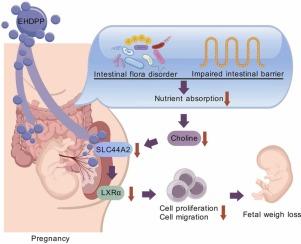EHDPP impairs intestinal microbiota homeostasis and induces placental injury through choline mediated gut-placenta axis
IF 11.3
1区 环境科学与生态学
Q1 ENGINEERING, ENVIRONMENTAL
引用次数: 0
Abstract
2-Ethylhexyl-diphenyl phosphate (EHDPP) is an organophosphate ester (OPE) with roles of flame retardant and plasticizer. It is widely used in various applications, detected in environmental matrices and human body, threatening ecological environment and human health. Some OPEs have been reported to disturb the gut microbiota, the gut microbiota mediates placental function. Our previous study showed EHDPP causes placental toxicity and fetal weight loss, it is unknown that whether EHDPP affects fetal development through the gut-placenta axis and whether it is feasible to fight against EHDPP induced placental toxicity through the gut-placenta axis. Our study investigates and indicates that EHDPP disrupts normal gut function by disturbing the gut microbiota homeostasis and compromising the intestinal barrier integrity. The disruption of EHDPP leads to reduced choline transporter expression of the solute carrier family 44A2 (SLC44A2), impaired choline absorption and distribution in placenta. Gut microbiota depletion increases the choline level in placenta. Both gut microbiota depletion and choline supplementation alleviate the EHDPP induced fetal weight loss by increasing the expression and activation of LXRα. In addition, a mendelian randomization study indicates that choline transporter SLC44A2 expression reduction significantly increased the risk of low birth weight in human. In summary, EHDPP exposure exacerbates placental and fetal damage through attenuating the beneficial function of choline mediated gut-placental axis. Direct choline supplementation or indirect choline level upregulation by gut microbiota depletion are therapeutic strategies for EHDPP induced placental injury.

EHDPP通过胆碱介导的肠-胎盘轴破坏肠道菌群稳态,诱导胎盘损伤
2-乙基己基磷酸二苯酯(EHDPP)是一种具有阻燃和增塑剂作用的有机磷酸酯(OPE)。它广泛应用于各种场合,在环境基质和人体中检测,威胁着生态环境和人体健康。据报道,一些OPEs会扰乱肠道微生物群,肠道微生物群调节胎盘功能。我们前期研究显示EHDPP可引起胎盘毒性和胎儿体重下降,但EHDPP是否通过肠-胎盘轴影响胎儿发育,以及通过肠-胎盘轴对抗EHDPP诱导的胎盘毒性是否可行尚不清楚。我们的研究调查并表明,EHDPP通过扰乱肠道微生物群稳态和损害肠道屏障完整性来破坏正常的肠道功能。EHDPP的破坏导致溶质载体家族44A2 (SLC44A2)胆碱转运蛋白表达减少,胆碱在胎盘中的吸收和分布受损。肠道菌群的减少增加了胎盘中的胆碱水平。肠道菌群消耗和胆碱补充均通过增加LXRα的表达和激活来减轻EHDPP诱导的胎儿体重减轻。此外,一项孟德尔随机化研究表明,胆碱转运体SLC44A2表达降低可显著增加人类低出生体重的风险。综上所述,EHDPP暴露通过削弱胆碱介导的肠-胎盘轴的有益功能,加重了胎盘和胎儿的损伤。直接补充胆碱或通过肠道菌群消耗间接上调胆碱水平是EHDPP诱导胎盘损伤的治疗策略。
本文章由计算机程序翻译,如有差异,请以英文原文为准。
求助全文
约1分钟内获得全文
求助全文
来源期刊

Journal of Hazardous Materials
工程技术-工程:环境
CiteScore
25.40
自引率
5.90%
发文量
3059
审稿时长
58 days
期刊介绍:
The Journal of Hazardous Materials serves as a global platform for promoting cutting-edge research in the field of Environmental Science and Engineering. Our publication features a wide range of articles, including full-length research papers, review articles, and perspectives, with the aim of enhancing our understanding of the dangers and risks associated with various materials concerning public health and the environment. It is important to note that the term "environmental contaminants" refers specifically to substances that pose hazardous effects through contamination, while excluding those that do not have such impacts on the environment or human health. Moreover, we emphasize the distinction between wastes and hazardous materials in order to provide further clarity on the scope of the journal. We have a keen interest in exploring specific compounds and microbial agents that have adverse effects on the environment.
 求助内容:
求助内容: 应助结果提醒方式:
应助结果提醒方式:


